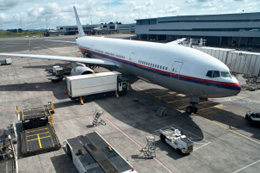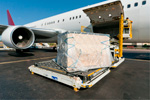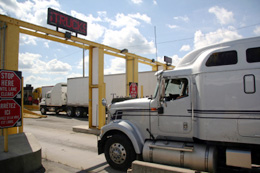THE CHALLENGE
A major Canadian manufacturer of finished high tech components was experiencing regular delays at U.S. airport hubs when shipping their products “Overnight Air” to U.S. destinations. Deliveries of these components were time-sensitive and expensive. Products were expected “Next Day AM”, so one or two day delays resulted in serious complaints from customers for both new products and replacement part shipments.
Based on Bay’s extensive experience importing products to and from the U.S. and Canada, develop a brokerage solution that would ensure on-time door-to-door AM deliveries for products to all states, eliminating delays at U.S. hub processing centers. This program had to include U.S. Customs brokerage services and be available Monday through Friday with Saturday delivery as an option.
THE SOLUTION
Start the process with Bay Logistics “same day clearance” at the Canadian border. Then have the freight picked up by Bay’s own fleet of trucks and cleared at U.S. Customs by Bay Brokerage. After clearance into the U.S., the freight was categorized as domestic air freight, delivered and loaded at the local airport that evening and then dispatched for delivery to the customers the following day for morning on-time delivery.
RESULTS
This complete Bay Solution resulted in immediate positive feedback from the Canadian manufacturer’s customers throughout the U.S. virtually eliminating late deliveries. Additionally, the Canadian shipper enjoyed a 27% savings over the former method.
THE CHALLENGE
A major Canadian manufacturer sells a variety of products direct to customers and resellers in the United States on a daily basis. With only certain products qualifying for free duty under the North American Free Trade Agreement (NAFTA), a percentage of the exported products were subject to duties thus resulting in considerable and on-going duty payments to U.S. Customs.
On-going shipment delays at U.S. Customs due to missing information or improper documentation were resulting in customers not receiving their orders on time. Because of the sheer volumes and variety of products, the first challenge was to develop a secure automated system that would accurately report each transaction to U.S. Customs in a timely manner. The new process had to be compliant with Trade Act of 2002 security criteria while meeting U.S. Customs airport entry requirements. To solve specific problems presented by product diversity and value assessment in real time, the system had to electronically categorize each commodity in U.S. Customs terms, while providing instant feedback for exceptions, restricted commodities or commodities with excessive values. All processes had to ensure timely and accurate data transmissions and visibility at the specific U.S. port of entry.
The next challenge was to develop an overview of the customers’ purchasing trends to determine which products qualified as duty-free and if alternative sourcing could qualify the completed products under a reduced duty rate or free of duties altogether. Finally, Bay had to prepare a recommendation for possible duty reductions based on analyses of their product types and the requirements (for duty) as set forth in the NAFTA agreements, GSP(General System of Preferences), and HTSUS Chapter 98(9801 and 9802).
THE SOLUTION
After an in-depth review, Bay found that under HTSUS 9802, products assembled abroad in whole or as part of fabricated components that were (a) exported in condition ready for assembly without further fabrication, (b) had not lost their physical identity in such articles by change in form, shape or otherwise, and (c) had not been advanced in value or improved in condition abroad except by being assembled and except by operations incidental to the assembly process such as cleaning, lubricating, and painting, were eligible for duty savings. All three requirements of subheading 9802.00.80 HTSUS, must be satisfied before a component may receive a duty allowance. Any significant process, operation, or treatment whose primary purpose is the fabrication, completion, physical or chemical improvement of a component precluded the application of the exemption under subheading 9802.00.80 HTSUS, to that component.
RESULT
The new system created by Bay Consulting and the ensuing analysis resulted in considerable duty savings for the Canadian manufacturer. Bay now uses this unique process on behalf of other cross-border manufacturing clients.
THE CHALLENGE
 A major U.S. e-tailer offered drop-ship services from its manufacturers direct to U.S. customers for hundreds of products in different categories sourced from China and Europe. Most transactions are small parcels valued at less than $800 – a key figure for procedures and fees at U.S. Customs. Clearing and tracking hundreds of shipments had become ineffective and unwieldy.
A major U.S. e-tailer offered drop-ship services from its manufacturers direct to U.S. customers for hundreds of products in different categories sourced from China and Europe. Most transactions are small parcels valued at less than $800 – a key figure for procedures and fees at U.S. Customs. Clearing and tracking hundreds of shipments had become ineffective and unwieldy.
On-going shipment delays at U.S. Customs due to missing information or improper documentation were resulting in customers not receiving their orders on time. Because of the sheer volumes and variety of products sold, the first challenge was to develop a secure automated system that would accurately report each transaction to U.S. Customs in a timely manner. The new process had to be compliant with Trade Act of 2002 security criteria while meeting U.S. Customs airport entry requirements. To solve specific problems presented by product diversity and value assessment in real time, the system had to electronically categorize each commodity in U.S. Customs terms, while providing instant feedback for exceptions, restricted commodities or commodities with excessive values. All processes had to ensure timely and accurate data transmissions and visibility at the specific U.S. port of entry.
THE SOLUTION
 Bay noted that based on the provisions of Section 321 of the Tariff Act, small parcel imports valued at less than $800 could be entered free of duty and tax, unless there was reason to believe that a shipment was one of several lots covered by a single order or that it was sent separately for the express purpose of securing free entry by avoiding compliance with any pertinent law or regulation. Section 321 also provides that eligible entries can be entered under informal entry procedures. As a nationally permitted U.S. Customs Broker, Bay Brokerage was able to build an electronic system providing advance notifications for incoming cargo at all the required ports. Because Bay is also a U.S. Customs Authorized Provider of Air AMS (Automated Manifest System), it was able to include notifications for air cargo while remaining fully compliant with the Trade Act.
Bay noted that based on the provisions of Section 321 of the Tariff Act, small parcel imports valued at less than $800 could be entered free of duty and tax, unless there was reason to believe that a shipment was one of several lots covered by a single order or that it was sent separately for the express purpose of securing free entry by avoiding compliance with any pertinent law or regulation. Section 321 also provides that eligible entries can be entered under informal entry procedures. As a nationally permitted U.S. Customs Broker, Bay Brokerage was able to build an electronic system providing advance notifications for incoming cargo at all the required ports. Because Bay is also a U.S. Customs Authorized Provider of Air AMS (Automated Manifest System), it was able to include notifications for air cargo while remaining fully compliant with the Trade Act.
THE RESULTS
Bay’s system eliminated unwarranted duty fees and penalties paid on hundreds of shipments from China and Europe. Minimizing delays greatly reduced order cancellations. On time delivery of shipments resulted in increased customer satisfaction and repeat business.
THE CHALLENGE
 A major Canadian distributor was purchasing small volumes of goods manufactured in the US and importing them to Canada for resale. These product shipments were brought in by international carriers and subject to LTL/Small Parcel freight rates that were 30-50% greater than equivalent rates in the US. With their existing methods, this importer was experiencing regular delays, misdirected freight and excessive freight charges based upon international tariffs. Bay Logistics was challenged to find a more cost-effective and time-efficient method for transporting these goods.
A major Canadian distributor was purchasing small volumes of goods manufactured in the US and importing them to Canada for resale. These product shipments were brought in by international carriers and subject to LTL/Small Parcel freight rates that were 30-50% greater than equivalent rates in the US. With their existing methods, this importer was experiencing regular delays, misdirected freight and excessive freight charges based upon international tariffs. Bay Logistics was challenged to find a more cost-effective and time-efficient method for transporting these goods.
THE SOLUTION
Bay Logistics implemented procedures routing all orders from US vendors to its US border warehouses. Orders were received and interlined with Bay’s fleet of trucks offering immediate delivery services to the Canadian destinations. Additionally, Bay negotiated a reduction in rates from the US carriers and got many of the distributors’ US vendors to offer free delivery when shipped to a US address. Using its proprietary software platform, this method allowed for better tracking of the goods, better preparation for Canadian Customs review, and more timely deliveries.
THE RESULTS
Bay’s new approach eliminated unwarranted duty fees and penalties paid on hundreds of shipments, resulting in a cost savings of 38% and an average reduction in transit time of 2 days to all Canadian locations.